《哈佛商业评论》经典解读系列
- 格式:ppt
- 大小:445.00 KB
- 文档页数:17
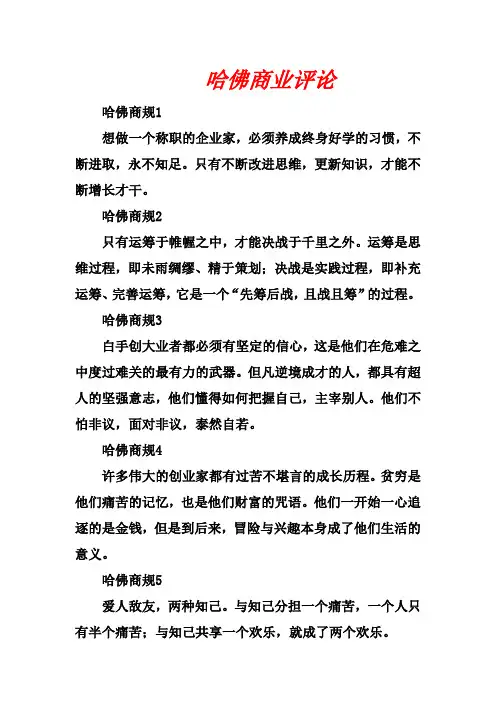
哈佛商业评论哈佛商规1想做一个称职的企业家,必须养成终身好学的习惯,不断进取,永不知足。
只有不断改进思维,更新知识,才能不断增长才干。
哈佛商规2只有运筹于帷幄之中,才能决战于千里之外。
运筹是思维过程,即未雨绸缪、精于策划;决战是实践过程,即补充运筹、完善运筹,它是一个“先筹后战,且战且筹”的过程。
哈佛商规3白手创大业者都必须有坚定的信心,这是他们在危难之中度过难关的最有力的武器。
但凡逆境成才的人,都具有超人的坚强意志,他们懂得如何把握自己,主宰别人。
他们不怕非议,面对非议,泰然自若。
哈佛商规4许多伟大的创业家都有过苦不堪言的成长历程。
贫穷是他们痛苦的记忆,也是他们财富的咒语。
他们一开始一心追逐的是金钱,但是到后来,冒险与兴趣本身成了他们生活的意义。
哈佛商规5爱人敌友,两种知己。
与知己分担一个痛苦,一个人只有半个痛苦;与知己共享一个欢乐,就成了两个欢乐。
哈佛商规6善于运用时间,做好计划安排。
绝不要浪费一分一秒在不能给自己带来好处的人和事上面,一个称职的经理会知道他下一步要做什么。
哈佛商规7闭上你的嘴,少说多做、多听。
言多必失——少说可保守你的秘密,多听可获取别人的秘密。
哈佛商规8把握主动权。
在情况还没发生变化之前就预测到变化,就采取对策,跟在别人后面一时,但不能跟在后面一世。
哈佛商规9从最简单的事做起。
从基层做起。
中国老话说:“集腋成裘,积沙成塔”,就是强调重视基础。
一个经理的成功不是一夜之间赚得的,而是一步一步积累的。
哈佛商规10保持敏锐的嗅觉。
抓取稍纵即逝的有益信息,深入下去钻研它,从中看到前景。
重要的是,采取行动也要迅速。
哈佛商规11一个公司尽管所选定的目标明确,所制定的策略也正确,还是会被自己的资源和实力所限制。
因此,成功的公司将根据本身条件而调整步伐,相时投资。
哈佛商规12知识越多,经验越丰富,在商业管理中所设想的问题便越多。
这可以使一个经理的眼光广阔,思路全面,决断正确,具有不断上进的雄心壮志。
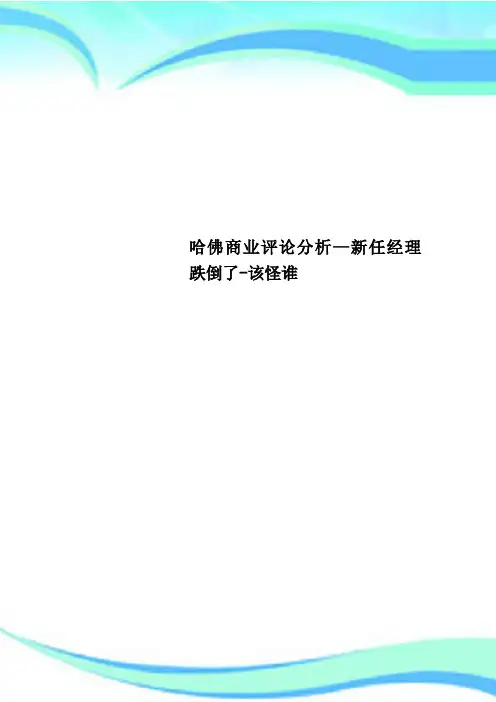
哈佛商业评论分析—新任经理跌倒了-该怪谁————————————————————————————————作者:————————————————————————————————日期:哈佛《商业评论》案例分析case A--新任经理犯了错,该怪谁2007年6月6日新任经理犯了错,该怪谁?戈登·阿德勒(Gordon Adler)[作者简介] 戈登·阿德勒,小说家和传播顾问,现定居瑞士图恩(Thun)。
他曾管理一家国际学校,撰写过商业、医学以及教育方面的文章和专著。
(通过一名新上任的经理人拉弗蒂*戈德斯通在担任经理人时出现的种种问题,反映了公司的经理人管理培训体系出了问题,很多成功的大公司都会在这个问题上出错,本文中出现的Bulwark也不例外。
)在我的上司保罗·麦金利(Paul MacKinley)那天在停车场挥手把我拦下之前,一切都很顺利。
麦金利是Bulwark证券公司明尼苏达州明尼阿波利斯分公司的经理。
那是1995年6月的一天,他当时就站在刺眼的阳光下,我眯起眼睛才看清是他。
“戈德斯通(Goldstone),”他说道,“马萨诸塞弗雷明汉的分公司有一个管理职位的空缺。
”我停好车,10分钟后找到了他。
他正俯身研究一张电子表格。
麦金利很在乎公司的经营利润,你得给他实现利润目标。
他总喜欢说,做好你自己的工作,不要给我惹官司。
他抬起头来看着我,“如果我没记错的话,戈德斯通,你从凯洛格商学院(Kellogg)获得了MBA学位,又做了8年的销售代表,可以说,你一直是在管理领域摸爬滚打。
”麦金利从不叫我拉弗蒂(Rafferty)。
“嗯,是的,我一直负责Centurion Graphics这个客户的协调工作。
我还曾是弗兰克·阿诺德(Frank Arnold)的顾问,销售拜访改进小组的成员。
”麦金利点了点头。
“管理就象征着权力、声望和金钱。
你还没到40吧?(完全错误的价值观:在我看来,管理的核心是如何建立一支有效地团队或者在已有团队中营造一种积极向上的氛围以鼓励员工用最饱满的精神状态和敬业精神投入到工作中去,来实现组织目标。
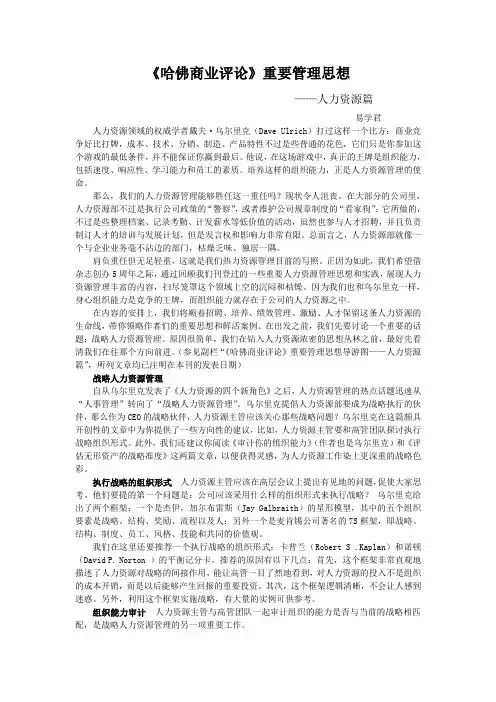
《哈佛商业评论》重要管理思想——人力资源篇易学君人力资源领域的权威学者戴夫·乌尔里克(Dave Ulrich)打过这样一个比方:商业竞争好比打牌,成本、技术、分销、制造、产品特性不过是些普通的花色,它们只是你参加这个游戏的最低条件,并不能保证你赢到最后。
他说,在这场游戏中,真正的王牌是组织能力,包括速度、响应性、学习能力和员工的素质。
培养这样的组织能力,正是人力资源管理的使命。
那么,我们的人力资源管理能够胜任这一重任吗?现状令人沮丧。
在大部分的公司里,人力资源部不过是执行公司政策的“警察”,或者维护公司规章制度的“看家狗”;它所做的,不过是些整理档案、记录考勤、计发薪水等低价值的活动,虽然也参与人才招聘,并且负责制订人才的培训与发展计划,但是发言权和影响力非常有限。
总而言之,人力资源部就像一个与企业业务毫不沾边的部门,枯燥乏味、独居一隅。
肩负重任但无足轻重,这就是我们热力资源管理目前的写照。
正因为如此,我们希望借杂志创办5周年之际,通过回顾我们刊登过的一些重要人力资源管理思想和实践,展现人力资源管理丰富的内容,扫尽笼罩这个领域上空的沉闷和枯燥。
因为我们也和乌尔里克一样,身心组织能力是竞争的王牌,而组织能力就存在于公司的人力资源之中。
在内容的安排上,我们将顺着招聘、培养、绩效管理、激励、人才保留这条人力资源的生命线,带你领略作者们的重要思想和鲜活案例。
在出发之前,我们先要讨论一个重要的话题:战略人力资源管理。
原因很简单,我们在钻入人力资源浓密的思想丛林之前,最好先看清我们在往那个方向前进。
(参见副栏“《哈佛商业评论》重要管理思想导游图——人力资源篇”,所列文章均已注明在本刊的发表日期)战略人力资源管理自从乌尔里克发表了《人力资源的四个新角色》之后,人力资源管理的热点话题迅速从“人事管理”转向了“战略人力资源管理”。
乌尔里克提倡人力资源部要成为战略执行的伙伴,那么作为CEO的战略伙伴,人力资源主管应该关心那些战略问题?乌尔里克在这篇颇具开创性的文章中为你提供了一些方向性的建议,比如,人力资源主管要和高管团队探讨执行战略组织形式。
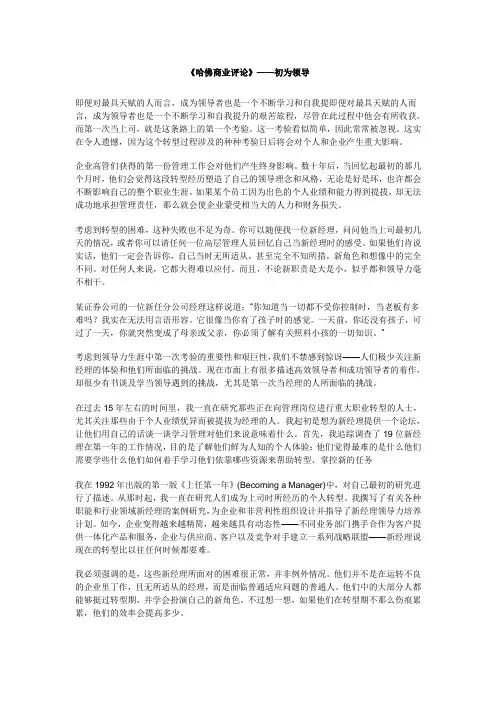
《哈佛商业评论》——初为领导即便对最具天赋的人而言,成为领导者也是一个不断学习和自我提即便对最具天赋的人而言,成为领导者也是一个不断学习和自我提升的艰苦旅程,尽管在此过程中他会有所收获。
而第一次当上司,就是这条路上的第一个考验。
这一考验看似简单,因此常常被忽视。
这实在令人遗憾,因为这个转型过程涉及的种种考验日后将会对个人和企业产生重大影响。
企业高管们获得的第一份管理工作会对他们产生终身影响。
数十年后,当回忆起最初的那几个月时,他们会觉得这段转型经历塑造了自己的领导理念和风格,无论是好是坏,也许都会不断影响自己的整个职业生涯。
如果某个员工因为出色的个人业绩和能力得到提拔,却无法成功地承担管理责任,那么就会使企业蒙受相当大的人力和财务损失。
考虑到转型的困难,这种失败也不足为奇。
你可以随便找一位新经理,问问他当上司最初几天的情况,或者你可以请任何一位高层管理人员回忆自己当新经理时的感受。
如果他们肯说实话,他们一定会告诉你,自己当时无所适从,甚至完全不知所措。
新角色和想像中的完全不同。
对任何人来说,它都大得难以应付。
而且,不论新职责是大是小,似乎都和领导力毫不相干。
某证券公司的一位新任分公司经理这样说道:“你知道当一切都不受你控制时,当老板有多难吗?我实在无法用言语形容。
它很像当你有了孩子时的感觉。
一天前,你还没有孩子,可过了一天,你就突然变成了母亲或父亲,你必须了解有关照料小孩的一切知识。
”考虑到领导力生涯中第一次考验的重要性和艰巨性,我们不禁感到惊讶——人们极少关注新经理的体验和他们所面临的挑战。
现在市面上有很多描述高效领导者和成功领导者的着作,却很少有书谈及学当领导遇到的挑战,尤其是第一次当经理的人所面临的挑战。
在过去15年左右的时间里,我一直在研究那些正在向管理岗位进行重大职业转型的人士,尤其关注那些由于个人业绩优异而被提拔为经理的人。
我起初是想为新经理提供一个论坛,让他们用自己的话谈一谈学习管理对他们来说意味着什么。
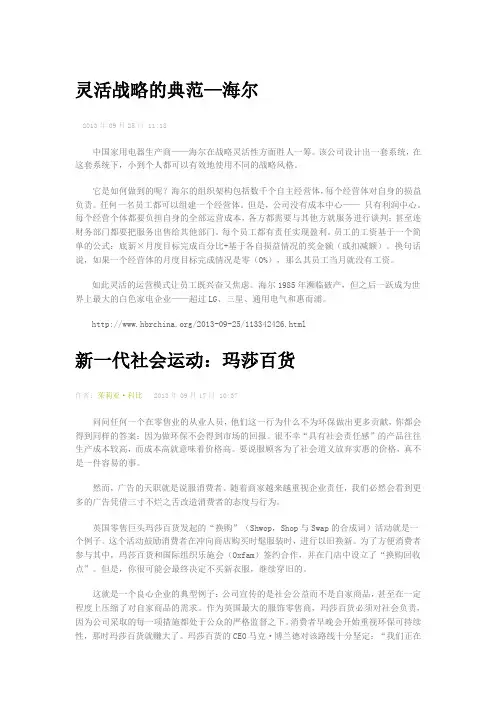
灵活战略的典范—海尔2013年09月25日 11:18中国家用电器生产商——海尔在战略灵活性方面胜人一筹。
该公司设计出一套系统,在这套系统下,小到个人都可以有效地使用不同的战略风格。
它是如何做到的呢?海尔的组织架构包括数千个自主经营体,每个经营体对自身的损益负责。
任何一名员工都可以组建一个经营体。
但是,公司没有成本中心——只有利润中心。
每个经营个体都要负担自身的全部运营成本,各方都需要与其他方就服务进行谈判;甚至连财务部门都要把服务出售给其他部门。
每个员工都有责任实现盈利。
员工的工资基于一个简单的公式:底薪×月度目标完成百分比+基于各自损益情况的奖金额(或扣减额)。
换句话说,如果一个经营体的月度目标完成情况是零(0%),那么其员工当月就没有工资。
如此灵活的运营模式让员工既兴奋又焦虑。
海尔1985年濒临破产,但之后一跃成为世界上最大的白色家电企业——超过LG、三星、通用电气和惠而浦。
/2013-09-25/113342426.html新一代社会运动:玛莎百货作者:茱莉亚·科比 2013年09月17日 10:37问问任何一个在零售业的从业人员,他们这一行为什么不为环保做出更多贡献,你都会得到同样的答案:因为做环保不会得到市场的回报。
很不幸“具有社会责任感”的产品往往生产成本较高,而成本高就意味着价格高。
要说服顾客为了社会道义放弃实惠的价格,真不是一件容易的事。
然而,广告的天职就是说服消费者。
随着商家越来越重视企业责任,我们必然会看到更多的广告凭借三寸不烂之舌改造消费者的态度与行为。
英国零售巨头玛莎百货发起的“换购”(Shwop,Shop与Swap的合成词)活动就是一个例子。
这个活动鼓励消费者在冲向商店购买时髦服装时,进行以旧换新。
为了方便消费者参与其中,玛莎百货和国际组织乐施会(Oxfam)签约合作,并在门店中设立了“换购回收点”。
但是,你很可能会最终决定不买新衣服,继续穿旧的。

哈佛商业评论(五篇模版)第一篇:哈佛商业评论《哈佛商业评论》最经典的两篇时间管理文章:《能量管理,而非时间》和《猴子在哪儿?》来源:邬浩的日志能量管理,而非时间作者:托尼?施瓦茨(Tony Schwartz)时间,是职场中人最感稀缺的资源。
很多经理人每天工作12到14个小时,很少正常吃饭,不是随便抓点什么匆匆填进肚子,就是坐在办公桌旁边干边吃;要么就是没完没了的应酬,无法与家人共进晚餐;睡眠不足,没有时间运动;心怀愧疚和不快,身心俱疲,这一切似乎已经成了经理人的生活常态。
我们大多数人都用延长工作时间的方法来应对日益繁重的工作任务,这不可避免地影响到我们的身体、心理和情绪。
就企业而言,这必将导致员工的工作积极性降低、精力涣散、离职率居高不下、医疗成本激增。
在过去5年里,作者所在的Energy Project公司为包括索尼公司和美联银行在内的一些大型组织提供了咨询和培训服务,通过一个名为“能量管理计划”的项目,帮助数千位领导人和管理者建立起良好的习惯,科学地管理他们的能量,而非时间。
最后的数据表明,参与该计划的员工的绩效表现均优于对照组,高能量能够创造出更高的绩效。
作者认为,延长工作时间之所以不可取,是因为时间是一种有限的资源。
相比之下,能量则不同。
物理学将能量(Energy)定义为工作时可资使用的潜在能力,对于人类来说,能量主要来自4个源泉--身体、情绪、思想和精神,通过形成特定的习惯,以上每个源泉都能为人类系统地增加并定时补充能量。
所谓特定的习惯,就是有意识地按照严格的时间表进行日常活动,并尽快使它们转变为无意识的、自动自觉的行为。
为了有效地给员工补充能量,组织的着眼点必须从“向员工索取更多”转移到“为员工付出更多”,这样,他们才会鼓足干劲,才能为每天的工作投入更多。
能量管理计划首先从对体能的关注开始,因为一个好的身体能够产生更多能量。
谁都知道营养不良、缺少运动、睡眠不足和休息不够会降低人的基础能量水平,削弱他们的情绪控制力和专注力。
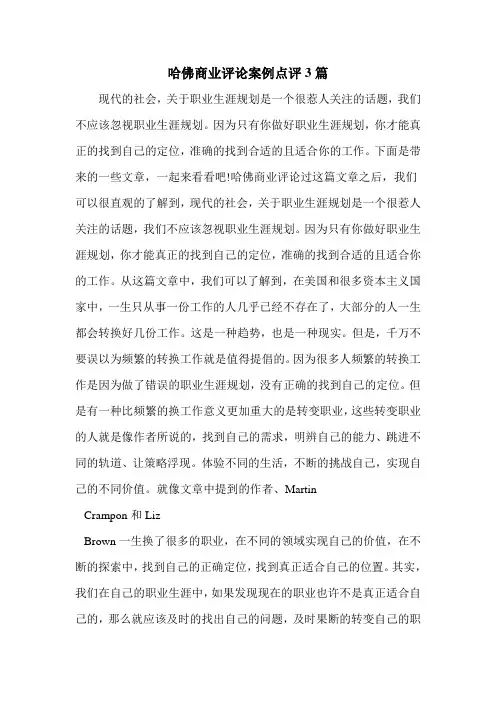
哈佛商业评论案例点评3篇现代的社会,关于职业生涯规划是一个很惹人关注的话题,我们不应该忽视职业生涯规划。
因为只有你做好职业生涯规划,你才能真正的找到自己的定位,准确的找到合适的且适合你的工作。
下面是带来的一些文章,一起来看看吧!哈佛商业评论过这篇文章之后,我们可以很直观的了解到,现代的社会,关于职业生涯规划是一个很惹人关注的话题,我们不应该忽视职业生涯规划。
因为只有你做好职业生涯规划,你才能真正的找到自己的定位,准确的找到合适的且适合你的工作。
从这篇文章中,我们可以了解到,在美国和很多资本主义国家中,一生只从事一份工作的人几乎已经不存在了,大部分的人一生都会转换好几份工作。
这是一种趋势,也是一种现实。
但是,千万不要误以为频繁的转换工作就是值得提倡的。
因为很多人频繁的转换工作是因为做了错误的职业生涯规划,没有正确的找到自己的定位。
但是有一种比频繁的换工作意义更加重大的是转变职业,这些转变职业的人就是像作者所说的,找到自己的需求,明辨自己的能力、跳进不同的轨道、让策略浮现。
体验不同的生活,不断的挑战自己,实现自己的不同价值。
就像文章中提到的作者、MartinCrampon和LizBrown一生换了很多的职业,在不同的领域实现自己的价值,在不断的探索中,找到自己的正确定位,找到真正适合自己的位置。
其实,我们在自己的职业生涯中,如果发现现在的职业也许不是真正适合自己的,那么就应该及时的找出自己的问题,及时果断的转变自己的职业,这是对自己负责任的表现,这样才能更好的贡献自己的价值。
就像以前看过一篇文章,是关于美国前国务卿赖斯。
她的一生转变几次职业。
她说,“我坚信,人不应沉湎于过去。
无论你以前当过什么,都不要老想着回到以前的那个自己。
转变也许你会发现一个全新的,更加完美的自己。
”那么,如何转变呢?首先,必须确定志向,志向是事业成功的基本前提,没有志向,事业的成功也就无从谈起。
俗话说:“志不立,天下无可成之事。
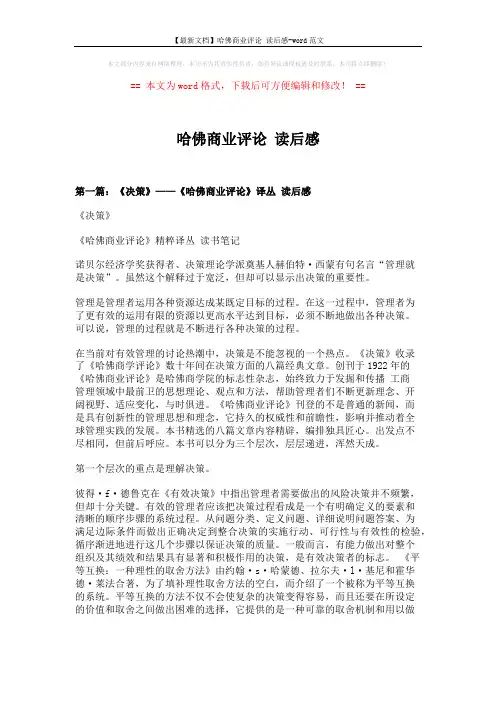
本文部分内容来自网络整理,本司不为其真实性负责,如有异议或侵权请及时联系,本司将立即删除!== 本文为word格式,下载后可方便编辑和修改! ==哈佛商业评论读后感第一篇:《决策》——《哈佛商业评论》译丛读后感《决策》《哈佛商业评论》精粹译丛读书笔记诺贝尔经济学奖获得者、决策理论学派奠基人赫伯特·西蒙有句名言“管理就是决策”。
虽然这个解释过于宽泛,但却可以显示出决策的重要性。
管理是管理者运用各种资源达成某既定目标的过程。
在这一过程中,管理者为了更有效的运用有限的资源以更高水平达到目标,必须不断地做出各种决策。
可以说,管理的过程就是不断进行各种决策的过程。
在当前对有效管理的讨论热潮中,决策是不能忽视的一个热点。
《决策》收录了《哈佛商学评论》数十年间在决策方面的八篇经典文章。
创刊于1922年的《哈佛商业评论》是哈佛商学院的标志性杂志,始终致力于发掘和传播工商管理领域中最前卫的思想理论、观点和方法,帮助管理者们不断更新理念、开阔视野、适应变化,与时俱进。
《哈佛商业评论》刊登的不是普通的新闻,而是具有创新性的管理思想和理念,它持久的权威性和前瞻性,影响并推动着全球管理实践的发展。
本书精选的八篇文章内容精辟,编排独具匠心。
出发点不尽相同,但前后呼应。
本书可以分为三个层次,层层递进,浑然天成。
第一个层次的重点是理解决策。
彼得·f·德鲁克在《有效决策》中指出管理者需要做出的风险决策并不频繁,但却十分关键。
有效的管理者应该把决策过程看成是一个有明确定义的要素和清晰的顺序步骤的系统过程。
从问题分类、定义问题、详细说明问题答案、为满足边际条件而做出正确决定到整合决策的实施行动、可行性与有效性的检验,循序渐进地进行这几个步骤以保证决策的质量。
一般而言,有能力做出对整个组织及其绩效和结果具有显著和积极作用的决策,是有效决策者的标志。
《平等互换:一种理性的取舍方法》由约翰·s·哈蒙德、拉尔夫·l·基尼和霍华德·莱法合著,为了填补理性取舍方法的空白,而介绍了一个被称为平等互换的系统。
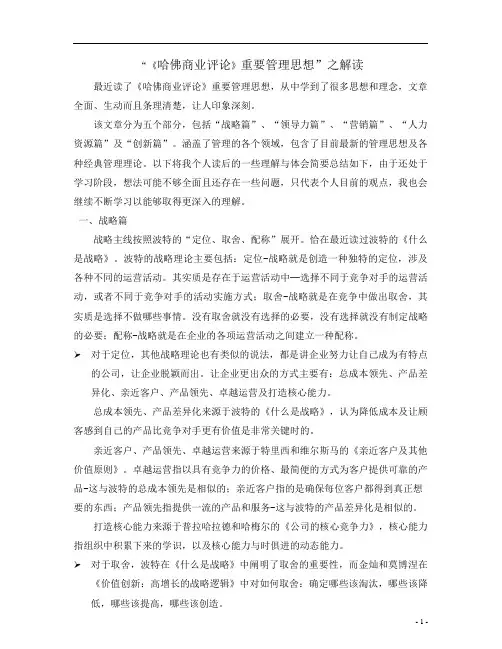
“《哈佛商业评论》重要管理思想”之解读最近读了《哈佛商业评论》重要管理思想,从中学到了很多思想和理念,文章全面、生动而且条理清楚,让人印象深刻。
该文章分为五个部分,包括“战略篇”、“领导力篇”、“营销篇”、“人力资源篇”及“创新篇”。
涵盖了管理的各个领域,包含了目前最新的管理思想及各种经典管理理论。
以下将我个人读后的一些理解与体会简要总结如下,由于还处于学习阶段,想法可能不够全面且还存在一些问题,只代表个人目前的观点,我也会继续不断学习以能够取得更深入的理解。
一、战略篇战略主线按照波特的“定位、取舍、配称”展开。
恰在最近读过波特的《什么是战略》。
波特的战略理论主要包括:定位-战略就是创造一种独特的定位,涉及各种不同的运营活动。
其实质是存在于运营活动中─选择不同于竞争对手的运营活动,或者不同于竞争对手的活动实施方式;取舍-战略就是在竞争中做出取舍,其实质是选择不做哪些事情。
没有取舍就没有选择的必要,没有选择就没有制定战略的必要;配称-战略就是在企业的各项运营活动之间建立一种配称。
对于定位,其他战略理论也有类似的说法,都是讲企业努力让自己成为有特点的公司,让企业脱颖而出。
让企业更出众的方式主要有:总成本领先、产品差异化、亲近客户、产品领先、卓越运营及打造核心能力。
总成本领先、产品差异化来源于波特的《什么是战略》,认为降低成本及让顾客感到自己的产品比竞争对手更有价值是非常关键时的。
亲近客户、产品领先、卓越运营来源于特里西和维尔斯马的《亲近客户及其他价值原则》。
卓越运营指以具有竞争力的价格、最简便的方式为客户提供可靠的产品-这与波特的总成本领先是相似的;亲近客户指的是确保每位客户都得到真正想要的东西;产品领先指提供一流的产品和服务-这与波特的产品差异化是相似的。
打造核心能力来源于普拉哈拉德和哈梅尔的《公司的核心竞争力》,核心能力指组织中积累下来的学识,以及核心能力与时俱进的动态能力。
对于取舍,波特在《什么是战略》中阐明了取舍的重要性,而金灿和莫博涅在《价值创新:高增长的战略逻辑》中对如何取舍:确定哪些该淘汰,哪些该降低,哪些该提高,哪些该创造。
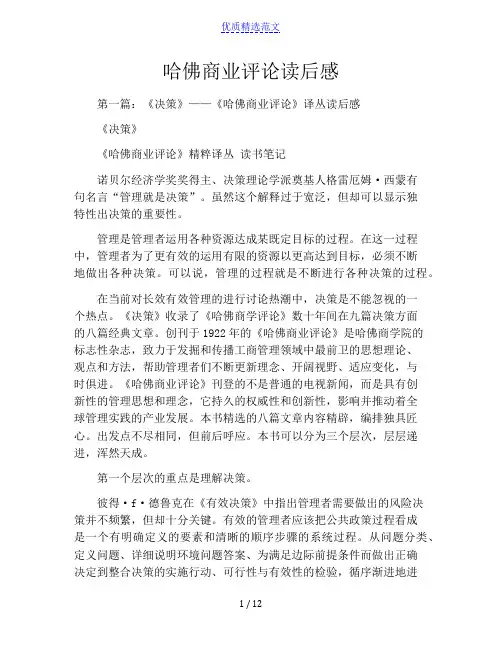
哈佛商业评论读后感第一篇:《决策》——《哈佛商业评论》译丛读后感《决策》《哈佛商业评论》精粹译丛读书笔记诺贝尔经济学奖奖得主、决策理论学派奠基人格雷厄姆·西蒙有句名言“管理就是决策”。
虽然这个解释过于宽泛,但却可以显示独特性出决策的重要性。
管理是管理者运用各种资源达成某既定目标的过程。
在这一过程中,管理者为了更有效的运用有限的资源以更高达到目标,必须不断地做出各种决策。
可以说,管理的过程就是不断进行各种决策的过程。
在当前对长效有效管理的进行讨论热潮中,决策是不能忽视的一个热点。
《决策》收录了《哈佛商学评论》数十年间在九篇决策方面的八篇经典文章。
创刊于1922年的《哈佛商业评论》是哈佛商学院的标志性杂志,致力于发掘和传播工商管理领域中最前卫的思想理论、观点和方法,帮助管理者们不断更新理念、开阔视野、适应变化,与时俱进。
《哈佛商业评论》刊登的不是普通的电视新闻,而是具有创新性的管理思想和理念,它持久的权威性和创新性,影响并推动着全球管理实践的产业发展。
本书精选的八篇文章内容精辟,编排独具匠心。
出发点不尽相同,但前后呼应。
本书可以分为三个层次,层层递进,浑然天成。
第一个层次的重点是理解决策。
彼得·f·德鲁克在《有效决策》中指出管理者需要做出的风险决策并不频繁,但却十分关键。
有效的管理者应该把公共政策过程看成是一个有明确定义的要素和清晰的顺序步骤的系统过程。
从问题分类、定义问题、详细说明环境问题答案、为满足边际前提条件而做出正确决定到整合决策的实施行动、可行性与有效性的检验,循序渐进地进行这几个以保证决策的质量。
一般而言,有能力做出对整个组织及其绩效和结果具有显著和积极作用的决策,是有效决策者的昭示。
《平等互换:一种理性的取舍方法》由约翰·s·哈蒙德、拉尔夫·l·基尼和霍华德·莱法合著,为了填补理性取舍方法的空白,而介绍了一个被叫做平等互换的公平系统。
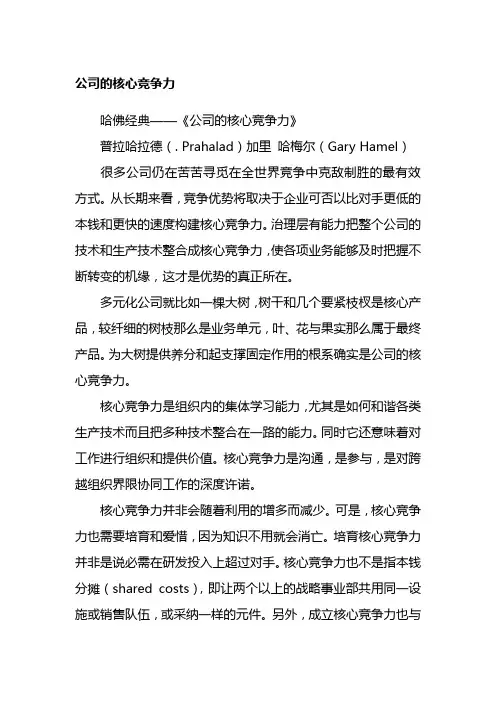
公司的核心竞争力哈佛经典——《公司的核心竞争力》普拉哈拉德(. Prahalad)加里哈梅尔(Gary Hamel)很多公司仍在苦苦寻觅在全世界竞争中克敌制胜的最有效方式。
从长期来看,竞争优势将取决于企业可否以比对手更低的本钱和更快的速度构建核心竞争力。
治理层有能力把整个公司的技术和生产技术整合成核心竞争力,使各项业务能够及时把握不断转变的机缘,这才是优势的真正所在。
多元化公司就比如一棵大树,树干和几个要紧枝杈是核心产品,较纤细的树枝那么是业务单元,叶、花与果实那么属于最终产品。
为大树提供养分和起支撑固定作用的根系确实是公司的核心竞争力。
核心竞争力是组织内的集体学习能力,尤其是如何和谐各类生产技术而且把多种技术整合在一路的能力。
同时它还意味着对工作进行组织和提供价值。
核心竞争力是沟通,是参与,是对跨越组织界限协同工作的深度许诺。
核心竞争力并非会随着利用的增多而减少。
可是,核心竞争力也需要培育和爱惜,因为知识不用就会消亡。
培育核心竞争力并非是说必需在研发投入上超过对手。
核心竞争力也不是指本钱分摊(shared costs),即让两个以上的战略事业部共用同一设施或销售队伍,或采纳一样的元件。
另外,成立核心竞争力也与纵向一体化不同,前者的目标加倍远大。
至少有三种查验方式能够用来确信公司的核心竞争力。
第一,核心竞争力能够为公司进入多个市场提供方便。
第二,核心竞争力应当对最终产品为客户带来的可感知价值有重大奉献。
最后一点,核心竞争力应当是竞争对手难以仿照的。
很多公司转向外部供给商以便削减内部投资的举动,事实上是把自己的核心竞争力拱手送给了他人。
另外,若是公司在现有业务中已经进展出了必要的能力,但以后却舍弃了成立核心竞争力的机遇,也会造成核心竞争力的流失。
为了保住核心竞争力的领先地位,公司都力图使核心产品——一种或多种核心竞争力的实物表现——活着界上的制造份额达到最大。
从事核心产品制造带来的销售收入和市场反馈至少部份地决定了核心竞争力改良和扩展的速度。
What Is Strategy?ContentsOperationalEffectiveness:Necessary butNot SufficientII. StrategyRests onUniqueActivitiesIII. ASustainableStrategicPositionRequiresTrade-offsIV. Fit DrivesBothCompetitiveAdvantage andSustainabilityV.RediscoveringStrategyJapaneseCompaniesRarely HaveStrategiesFinding NewPositions: TheEntrepreneurialEdgeThe Connectionwith GenericStrategiesAlternativeI. Operational Effectivene ss Is Not Strategy For almost two decades, managers have been learning to play by a new set of rules. Companies must be flexible to respond rapidlyto competitive and market changes. They must benchmarkcontinuously to achieve best practice. They must outsourceaggressively to gain efficiencies. And they must nutture a few corecompetencies in the race to stay ahead of rivals.Positioning-once the heart of strategy-is rejected as too static fortoday's dynamic markets and changing technologies. According tothe new dogma, rivals can quickly copy any market position, andcompetitive advantage is, at best, temporary.But those beliefs are dangerous half-truths, and they are leadingmore and more companies down the path of mutually destructivecompetition. True, some barriers to competition are falling asregulation eases and markets become global. True, companieshave properly invested energy in becoming leaner and morenimble. In many industries, however, what some callhypercompetition is a self-inflicted wound, not the inevitableoutcome of a changing paradigm of competition.The root of the problem is the failure to distinguish betweenoperational effectiveness and strat egy. The quest for productivity,quality, and speed has spawned a remarkable number ofmanagement tools and techniques: total quality management,`benchmarking, time-based competition, outsourcing, partnering,reengineering, change management. Although the resultingoperational improvements have often been dramatic, manycompanies have been frustrated by their inability to translate those gains into sustainable profitability. And bit by bit, almost imperceptibly, management tools have taken the place of strategy. As managers push to improve on all fronts, they move farther away from viable competitive positions. Operational Effectiveness: Necessary but Not Sufficient Operational effectiveness and strategy are both essential to superior performance, which, after all, is the primary goal of any enterprise. But they work in very different ways.A company can outperform rivals only if it can establish a difference that it can preserve. It must deliver greater value to customers or create comparable value at a lower cost, or do both. The arithmetic of superior profitability then follows: delivering greater,value allows a company to charge higher average unit prices; greater efficiency results in lower average unit costs. Views of StrategyThe Origins Strategic P ositions Types of Fit Fit and Sustainability The Failure to Choose The Grow th Trap P rofitable Growth The Role of Leadership The Implicit Strategy Model of the P ast Decade Sustainable Competitive AdvantageUltimately, all differences between companies in cost or price derive from the hundreds of activities required to create, produce, sell, and deliver their products or services, such as calling on customers, assembling final products, and training employees. Cost is generated by performing activities, and cost advantage arises from performing particular activities more efficiently than competitors. Similarly, differentiation arises from both the choice of activities and how they are performed. Activities, then, are the basic units of competitive advantage. Overall advantage or disadvantage results from all a company's activities, not only a few.'Operational effectiveness fOE) means performing similar activities better than rivals perform them. Operational effectiveness includes but is not limited to efficiency. It refers to any number of practices that allow a company to better utilize its inputs by, for example, reducing defects in products or developing better products faster. In contrast, strategic positioning means performing different activities from rivals' or performing similar activities in different ways.GRAPH: Operational Effectiveness Versus Strategic PositioningDifferences in operational effectiveness among companies are pervasive. Some companies are able to get more out of their inputs than others because they eliminate wasted effort, employ more advanced technology, motivate employees better, or have greater insight into managing particular activities or sets of activities. Such differences in operational effectiveness are an important source of differences in profitability among competitors because they directly affect relative cost positions and levels of differentiation.Differences in operational effectiveness were at the heart of the Japanese challenge to Western companies in the 1980s. The Japanese were so far ahead of rivals in operational effectiveness that they could offer lower cost and superior quality at the same time. It is worth dwelling on this point, because so much recent thinking about competition depends on it. Imagine for a moment a productivity frontier that constitutes the sum of all existing best practices at any given time. Think of it as the maximum value that a company delivering a particular product or service can create at a given cost, using the best available technologies, skills, management techniques, and purchased inputs. The productivity frontier can apply to individual activities, to groups of linked activities such as order processing and manufacturing, and to an entire company's activities. When a company improves its operational effectiveness, it moves toward the frontier. Doing so may require capital investment, different personnel, or simply new ways of managing.The productivity frontier is constantly shifting outward as new technologies and management approaches are developed and as new inputs become available. Laptop computers, mobile communications, the Internet, and software such as Lotus Notes, for example, have redefined the productivity frontier for sales-force operations and created rich possibilities for linking sales with such activities as order processing and after-salessupport. Similarly, lean production, which involves a family of activities, has allowed substantial improvements in manufacturing productivity and asset utilization.For at least the past decade, managers have been preoccupied with improving operational effectiveness. Through programs such as TQM, time-based competition, and benchmarking, they have changed how they perform activities in order to eliminate inefficiencies, improve customer satisfaction, and achieve, best practice. Hoping to keep up with shifts in the productivity 'frontier, managers have embraced continuous improvement, empowerment, change management, and the so-called learning organization. The popularity of outsourcing and the virtual corporation reflect the growing recognition that it is difficult to perform all activities as productively as specialists.As companies move to the frontier, they can often improve on multiple dimensions of performance at the same time. For example, manufacturers that adopted the Japanese practice of rapid changeovers in the 1980s were able to lower cost and improve differentiation simultaneously. What were once believed to be real trade-offs- between defects and costs, for example- turned out to be illusions created by poor operational effectiveness. Managers have learned to reject such false trade-offs.Constant improvement in operational effectiveness is necessary to achieve superior profitability. However, it is not usually sufficient. Few companies have competed successfully on the basis of operational effectiveness over an extended period, and staying ahead of rivals gets harder every day. The most obvious reason for that is the rapid diffusion of best practices. Competitors can quickly imitate management techniques, new technologies, input improvements, and superior ways of meeting customers' needs. The most generic solutions- those that can be used in multiple settings- diffuse the fastest. Witness the proliferation of OE techniques accelerated by support from consultants.OE competition shifts the productivity frontier outward, effectively raising the bar for everyone. But although such competition produces absolute improvement in operational effectiveness, it leads to relative improvement for no one. Consider the $5 billion-plus U.S. commercial-printing industry. The major players- R.R. Donnelley & Sons Company, Quebecor, World Color Press, and Big Flower Press-are competing head to head, serving all types of customers, offering the same array of printing technologies (gravure and web offset), investing heavily in the same new equipment, running their presses faster, and reducing crew sizes. But the resulting major productivity gains are being captured by customers and equipment suppliers, not retained in superior profitability. Evenindustry-leader Donnelley's profit margin, consistently higher than 7% in the 1980s, fell to less than 4.6% in 1995. This pattern is playing itself out in industry after industry. Even the Japanese, pioneers of the new competition, suffer from persistently low profits. (See the insert "Japanese Companies Rarely Have Strategies.")The second reason that improved operational effectiveness is insufficient- competitiveconvergence- is more subtle and insidious. The more benchmarking companies do, the more they look alike. The more that rivals outsource activities to efficient third parties, often the same ones, the more generic those activities become. As rivals imitate one another's improvements in quality, cycle times, or supplier partnerships, strategies converge and competition becomes a series of races down identical paths that no one can win. Competition based on operational effectiveness alone is mutually destructive, leading to wars of attrition that can be arrested only by limiting competition.The recent wave of industry consolidation through mergers makes sense in the context of OE competition. Driven by performance pressures but lacking strategic vision, company after company has had no better idea than to buy up its rivals. The competitors left standing are often those that outlasted others, not companies with real advantage.After a decade of impressive gains in operational effectiveness, many companies are facing diminishing returns. Continuous improvement has been etched on managers' brains. But its tools unwittingly draw companies toward imitation and homogeneity. Gradually, managers have let operational effectiveness supplant strategy. The result is zerosum competition, static or declining prices, and pressures on costs that compromise companies' ability to invest in the business for the long term.II. Strategy Rests on Unique ActivitiesCompetitive strategy is about being different. It means deliberately choosing a different set of activities to deliver a unique mix of value.Southwest Airlines Company, for example, offers short-haul, low-cost, point-to-point service between midsize cities and secondary airports in large cities. Southwest avoids large airports and does not fly great distances. Its customers include business travelers, families, and students. Southwest's frequent departures and low fares attract pricesensitive customers who otherwise would travel by bus or car, andconvenience-oriented travelers who would choose a full-service airline on other routes.Most managers describe strategic positioning in terms of their customers:"Southwest Airlines serves price- and convenience-sensitive travelers," for example. But the essence of strategy is in the activities-choosing to perform activities differently or to perform different activities than rivals. Otherwise, a strategy is nothing more than a marketing slogan that will not withstand competition.A full-service airline is configured to get passengers from almost any point A to any pointB. To reach a large number of destinations and serve passengers with connecting flights, full-service airlines employ a hub-and-spoke system centered on major airports. To attract passengers who desire more comfort, they offer first-class or businessclass service. To accommodate passengers who must change planes, they coordinate schedules and check and transfer baggage. Because some passengers will be traveling for many hours, full-service airlines serve meals.Southwest, in contrast, tailors all its activities to deliver low-cost, convenient service on its particular type of route. Through fast turnarounds at the gate of only 15 minutes, Southwest is able to keep planes flying longer hours than rivals and provide frequent departures with fewer aircraft. Southwest does not offer meals, assigned seats, interline baggage checking, or premium classes of service. Automated ticketing at the gate encourages customers to bypass travel agents, allowing Southwest to avoid their commissions. A standardized fleet of 737 aircraft boosts the efficiency of maintenance.Southwest has staked out a unique and valuable strategic position based on a tailored set of activities. On the routes served by Southwest, a full-service airline could never be as convenient or as low cost.Ikea, the global furniture retailer based in Sweden, also has a clear strategic positioning. Ikea targets young furniture buyers who want style at low cost. What turns this marketing concept into a strategic positioning is the tailored set of activities that make it work. Like Southwest, Ikea has chosen to perform activities differently from its rivals.Consider the typical furniture store. Showrooms display samples of the merchandise. One area might contain 25 sofas; another will display five dining tables. But those items represent only a fraction of the choices available to customers. Dozens of books displaying fabric swatches or wood samples or alternate styles offer customers thousands of product varieties to choose from. Salespeople often escort customers through the store, answering questions and helping them navigate this maze of choices. Once a customer makes a selection, the order is relayed to a third-party manufacturer. With luck, the furniture will be delivered to the customer's home within six to eight weeks. This is a value chain that maximizes customization and service but does' so at high cost.In contrast, Ikea serves customers who are happy to trade off service for cost. Instead of having a sales associate trail customers around the stor e, Ikea uses a self-service model based on clear, instore displays. Rather than rely solely on thirdparty manufacturers, Ikea designs its own low-cost, modular, ready-to-assemble furniture to fit its positioning. In huge stores, Ikea displays every product . it sells in room-like settings, so customers don't need a decorator to help them imagine how to put the pieces together. Adjacent to the furnished showrooms is a warehouse section with the products in boxes on pallets. Customers are expected to do their own pickup and delivery, and Ikea will even sell you a roof rack for your car that you can return for a refund on your next visit.DIAGRAM: Mapping Activity SystemsAlthough much of its low-cost position comes from having customers "do it themselves," Ikea offers a number of extra services that its competitors do not. In-store child care is one. Extended hours are another. Those services are uniquely aligned with the needs of its customers, who are young, not wealthy, likely to have children (but no nanny), and, because they work for a living, have a need to shop at odd hours.The Origins Strategic PositionsStrategic positions emerge from three distinct sources, which are not mutually exclusive and often overlap. First, positioning can be based on producing a subset of an industry's products or services. I call this variety-based positioning because it is based on the choice of product or service varieties rather than customer segments. Variety-based positioning makes economic sense when a company. can best produce particular products or services using distinctive sets of activities.Jiffy Lube International, for instance, specializes in automotive lubricants and does not offer other car repair or maintenance services. Its value chain produces faster servic e at a lower cost than broader line repair shops, a combination so attractive that many customers subdivide their purchases, buying oil changes from the focused competitor, Jiffy Lube, and going to rivals for other services.The Vanguard Group, a leader in the mutual fund industry, is another example ofvariety-based positioning. Vanguard provides an array of common stock, bond, and money market funds that offer predictable performance and rock-bottom expenses. The company's investment approach deliberately sacrifices the possibility of extraordinary performance in any one year for good relative performance in every year. Vanguard is known, for example, for its index funds. It avoids making bets on interest rates and steers clear of narrow stock groups. Fund managers keep trading levels low, which holds expenses down; in addition, the company discourages customers from rapid buying and selling because doing so drives up costs and can force a fund manager to trade in order to deploy new capital and raise cash for redemptions. Vanguard also takes a consistent low-cost approach to managing distribution, customer service, and marketing. Many investors include one or more Vanguard funds in their portfolio, while buying aggressively managed or specialized funds from competitors.The people who use Vanguard or Jiffy Lube are responding to a superior value chain for a particular type of service. A variety-based positioning can serve a wide array of customers, but for most it will meet only a subset of their needs.A second basis for positioning is that of serving most or all the needs of a particular group of customers. I call this needs-based positioning, which comes closer to traditional thinking about targeting a segment of customers. It arises when there are groups of customers with differing needs, and when a tailored set of activities can serve those needs best. Some groups of customers are more price sensitive than others, demand different product features, and need varying amounts of information, support, and services. Ikea's customers are a good example of such a group. Ikea seeks to meet all the home furnishing needs of its target customers, not just a subset of them.A variant of needs-based positioning arises when the same customer has different needs on different occasions or for different types of transactions. The same person, for example, may have different needs when traveling on business than when traveling forpleasure with the family. Buyers of cans-beverage companies, for example-will likely have different needs from their primary supplier than from their secondary source.It is intuitive for most managers to conceive of their business in terms of the customers' needs they are meeting.. But a critical element of needs-based positioning is not at all intuitive and is often overlooked. Differences in needs will not translate into meaningful positions unless the best set of activities to satisfy them also differs. If that were not the case, every competitor could meet those same needs, and there would be nothing unique or valuable about the positioning.In private banking, for example, Bessemer Trust Company targets families with a minimum of $5 million in investable assets who want capital preservation combined with wealth accumulation. By assigning one sophisticated account officer for every 14 families, Bessemer has configured its activities for personalized service. Meetings, for example, are more likely to be held at a client's ranch or yacht than in the office. Bessemer offers a wide array of customized services, including investment management and estate administration, .oversight of oil and gas investments, and accounting for racehorses and aircraft. Loans, a staple of most private banks, are rarely needed by Bessemer's clients and make up a tiny fraction of its client balances and income. Despite the most generous compensation of account officers and the highest personnel cost as a percentage of operating expenses, Bessemer's differentiation with its target families produces a return on equity estimated to be the highest of any private banking competitor.Citibank's private bank, on the other hand, serves clients with minimum assets of about $250,000 who, in contrast to Bessemer's clients, want convenient access to loans-from jumbo mortgages to deal financing. Citibank's account managers are primarily lenders. When clients need other services, their account manager refers them to other Citibank specialists, each of whom handles prepackaged products. Citibank's system is less customized than Bessemer's and allows it to have a lower manager-to-client ratio of1:125. Biannual office meetings are offered only for the largest clients. Both Bessemer and Citibank have tailored their activities to meet the needs of a different group of private banking customers. The same value chain cannot profitably meet the needs of both groups.The third basis for positioning is that of segmenting customers who are accessible in different ways. Although their needs are similar to those of other customers, the best configuration of activities to reach them is different. I call this access-based positioning. Access can be a function of cus, tomer geography or customer scale-or of anything that requires a different set of activities to reach customers in the best way.Segmenting by access is less common and less well understood than the other two bases. Carmike Cinemas, for example, operates movie theaters exclusively in cities and towns with populations un-der 200,000. How does Carmike make money in markets that are not only small but also won't support big-city ticket prices? It does so through a set ofactivities that result in a lean cost structure. Carmike,s small-town customers can be served through standardized, low-cost theater complexes requiring fewer screens and less sophisticated projection technology than big-city theaters. The company's proprietary information system and management process eliminate the need for local administrative staff beyond a single theater manager. Carmike also reaps advantages from centralized purchasing, lower rent and payroll costs (because of its locations), and rock-bottom corporate overhead of 2% (the industry average is 5%). Operating in small communities also allows Carmike to practice a highly personal form of marketing in which the theater manager knows patrons and promotes attendance through personal contacts. By being the dominant if not the only theater in its markets-the main competition is often the high school football team-Carmike is also able to get its pick of films and negotiate b etter terms with distributors.Rural versus urban-based customers are one example of access driving differences in activities. 'Serving small rather than large customers or densely rather than sparsely situated customers are other examples in which the best way to configure marketing, order processing, logistics, and after-sale service activities to meet the similar needs of distinct groups will often differ.Positioning is not only about carving out a niche. A position emerging from any of the sources can be broad.or narrow. A focused competitor, such as Ikea, targets the special needs of a subset of customers and designs its activities accordingly. Focused competitors thrive on groups of customers who are over-served (and hence overpriced) by more broadly targeted competitors, or underserved (and hence underpriced). A broadly targeted competitor,for example, Vanguard or Delta Air Lines- serves a wide array of customers, performing a set of activities designed to meet their common needs. It ignores or meets only partially the more idiosyncratic needs of particular customer groups.Whatever the basis- variety, needs, access, or some combination of the three- positioning requires a tailored set of activities because it is always a function of differences on the supply side; that is, of differences in activities. However, positioning is not always a function of differences on the demand, or customer, side. Variety and access positionings, in particular, do not rely on any customer differences. In practice, howeve r, variety or access differences often accompany needs differences. The tastes-that is, the needs-of Carmike's small-town customers, for instance, run more toward comedies, Westerns, action films, and family entertainment. Carmike does not run any films rated NC- 17.Having defined positioning, we can now begin to answer the question, "What is strategy?" Strategy is the creation of a unique and valuable position, involving a different set of activities. If there were only one ideal position, there would be no need for strategy. Companies would face a simple imperative-win the race to discover and preempt it. The essence of strategic positioning is to choose activities that are different from rivals'. If thesame set of activities were best to produce all varieties, meet all needs, and access all customers, companies could easily shift among them and operational effectiveness would determine performance.III. A Sustainable Strategic Position Requires Trade-offsChoosing a unique position, however, is not enough to guarantee a sustainable advantage. A valuable position will attract imitation by incum bents, who are likely to copy it in one of two ways.First, a competitor can reposition itself to.match the superior performer. J.C. Penney, for instance, has been repositioning itself from a Sears clone to a more upscale,fashion-oriented, soft-goods retailer. A second and far more common type of imitation is straddling. The straddler seeks to match the benefits of a successful position while maintaining its existing position. It grafts new features, services, or technologies onto the activities it already performs.For those who argue that competitors can copy any market position, the airline industry is a perfect test case. It would seem that nearly any competitor could imitate any other airline's activities. Any airline can buy the same planes, lease the gates, and match the menus and ticketing and baggage handling services offered by other airlines.Continental Airlines saw how well Southwest was doing and decided to straddle. While maintaining its position as a full-service airline, Continental also set out to match Southwest on a number of point-to-point routes. The airline dubbed the new service Continental Lite. It eliminated meals and first-class service, increased departure frequency, lowered fares, and shortened turnaround time at the gate. Because Continental remained a full-service airline on other routes, it continued to use travel agents and its mixed fleet of planes and to provide baggage checking and seat assignments.But a strategic position is not sustainable unless there are trade-offs with other positions. Trade-offs occur when activities are incompatible. Simply put, a trade-off means that more of one thing necessitates less of another. An airline can choose to serve meals- adding cost and slowing turnaround time at the gate-or it can choose not to, but it cannot do both without bearing major inefficiencies.Trade-offs create the need for choice and protect against repositioners and straddlers. Consider Neutrogena soap. Neutrogena Corporation's Variety-based positioning is built on a "kind to the skin," residue-free soap formulated for pH balance. With a large detail force calling on dermatologists, Neutrogena's marketing strategy looks more like a drug company's than a soap maker's. It advertises in medical journals, sends direct mail to doctors, attends medical conferences, and performs research at its own Skincare Institute. To reinforce its positioning, Neutrogena originally focused its distribution on drugstores and avoided price promotions. Neutrogena uses a slow, more expensive。
风浪口推荐--《哈佛商业评论》史上25篇最佳文章《哈佛商业评论》里25篇金光闪闪的佳作1 《苦行僧的启示》,1997年5/6月,由Bowen McCoy 发表(原发布于1983年)2 《什么是战略》,作者Michael Porter,发表于1996年11/12月3 《构建性格的原则》,作者Joseph Badaracco,发表于1998年3/4月4 《跨边界谈判的潜在挑战》,作者James Sebenius,发表于2002年3月5 《领导变革:为什么改革的努力会失败》,作者John Kotter,发表于2007年元月(原发布于1995年3/4月)6 《形成战略的五种竞争性力量》,作者Michael Porter,发表于2008 年元月7 《领导者是怎么炼成的》,作者Daniel Goleman,发表于2004 年元月(原发布于1998年11/12月)8 《领导者真正在做什么》,作者John Kotter,发表于2001年12月(原发布于1990年5/6月)9 《运用劝说的科学》,作者Robert Cialdini,发表于2001年10月10 《实现目标的领导艺术》,作者Daniel Goleman,发表于2000年3/4月11 《CEO 在业务模式再造中的作用》,作者Vijay Govindarajan 和Chris Trimble,发表于2011年1/2月12 《打造共同的信念》,作者Michael Porter 和Mark Kramer,2011年1/2月13 《自我管理》,作者Peter Drucker,2005年1月(原发布于1999年3/4月)14 《发现你真正的领导力》,作者Bill George、Peter Sims、Andrew McLean 和Diana Mayer,发表于2007年2月15 《蓝海战略》,作者W. Chan Kim 和Renee Mauborgne,发表于2004年10月16 《第五层领导力:化解谦卑和激烈的胜利》,作者by Jim Collins,2005年7月(原发布于2001年元月)17 《你能说出自己的战略是什么?》,作者David Collis 和Michael Rukstad,2008 年4 月18 《团队纪律》作者Jon Katzenbach 和Douglas Smith,2005年7/8月(原发布于1993年3/4月)19 《管好你的老板》,作者John Gabarro 和John Kotter,发表于2005年元月(原发布于1980年元/2月)20 《建立您的企业愿景》,作者James Collins 和Jerry Porras,发表于1996年9/10月21 《决策中的隐形陷阱》,作者John Hammond、Ralph Keeney、和Howard Raiffa,发表于2006年元月(原发布于1998年9/10月)22 《战略与社会:竞争优势与企业社会责任的关系》,作者Michael Porter 和Mark Kramer,发表于2006 年12月23 《管理的时间:钱到了谁手里》,作者William Oncken 和Donald Wass,1999年11/12月(原发布于1974年11/12月)24 《为什么有人听你的?》,作者Robert Goffee 和Gareth Jones,发表于2000年9/10月25 《短视营销》,作者Theodore Levitt,发表于2004年7/8月(最早发布于19607/8月)。
领导者应该做什么领导(leadership)与管理(management)不同,但是不同的原因与大多数人所认为的并不一样。
领导既不玄妙也不神秘,它与"超凡魅力"(charisma)或者其他异乎寻常的个性特征没有关系。
领导不是少数人的专利。
领导未必优于管理,也未必可以取代管理。
确切地说,领导与管理是两种并不相同而又互为补充的行为体系,各有自己的功能和特点。
在日趋复杂、变化无常的商业环境中,这两者都是取得成功的必备条件。
真正的挑战是,把很强的领导能力和很强的管理能力结合起来,并使两者相互制衡。
管理与处理复杂情况有关。
管理的实践和程序主要是对20世纪最重要的发展之一——大型组织的出现——所做出的一个反应。
如果没有好的管理,复杂的企业可能会杂乱无章,面临生存危机。
好的管理给诸如产品的质量和赢利能力等关键指标带来一定的秩序和连贯性。
相比之下,领导与应对变革有关。
近年来领导变得如此重要的部分原因是,现在的商业世界竞争更加激烈、更加变化无常。
要在这种新的环境中生存下去并有效地进行竞争,重大变革就变得越来越有必要。
更多的变革总是需要更多的领导力。
处理复杂情况和应对变革这两种不同职能,形成了管理行为和领导行为的特征。
两个行为体系都涉及:决定需要做什么,建立完成一项计划所需要的员工与关系网络,努力确保这些员工各尽其职。
但是,领导和管理完成这三项任务的方法各不相同。
公司管理复杂情况的第一步是做计划和做预算——为将来(通常是下个月或者下一年)设定指标或目标,制订完成这些目标的具体步骤,然后分配资源来完成计划。
与此形成对比的是,领导一个组织进行建设性的变革始于确定方向——制定未来(通常是遥远的未来)的远景,并为达到远景所需要的种种变革制定相应的战略。
做计划本质上是演绎性的,目的是要产生有序的结果,而不是变化。
确定方向更具归纳性,领导者广泛收集数据,从中寻找能够对事物进行解释的模式、关系和关联。
管理通过组织和配备人员来发展完成计划的能力,具体做法是:创立组织结构,并按实现计划的要求设立一系列工作岗位;为这些工作岗位配备称职的人员;与这些人员就计划进行沟通;下放权力让员工执行计划;以及设计执行计划的监控系统。